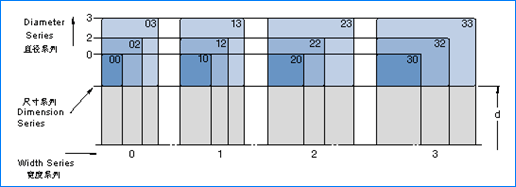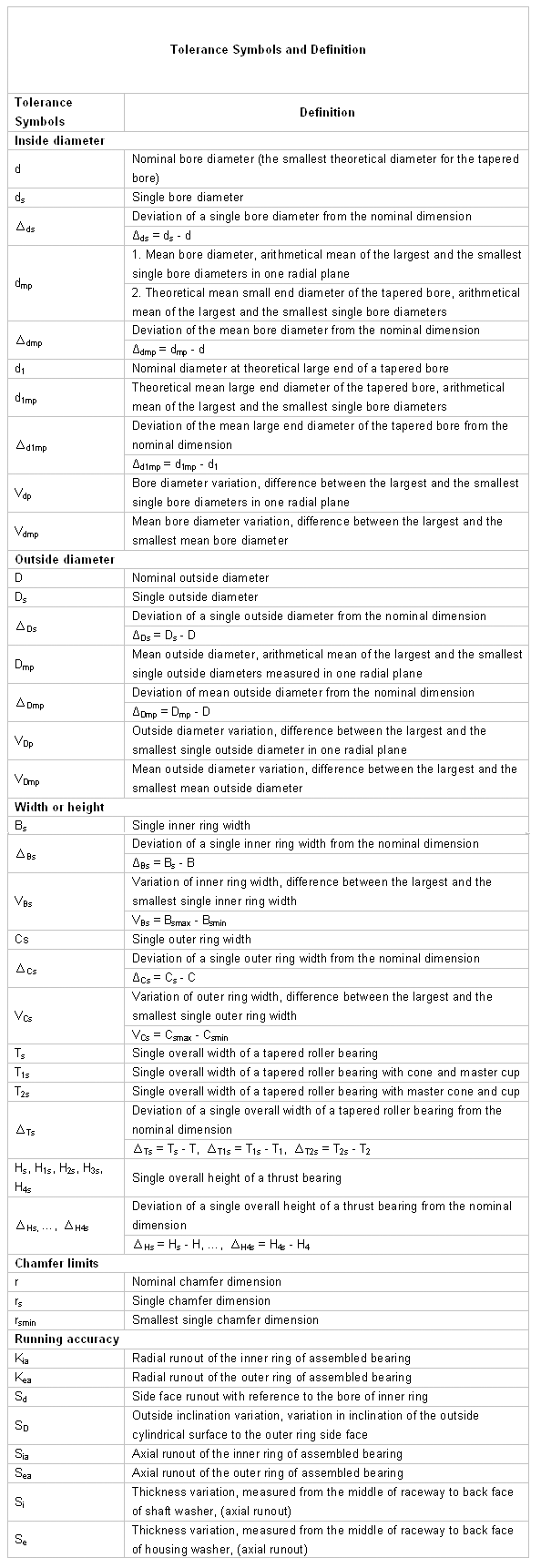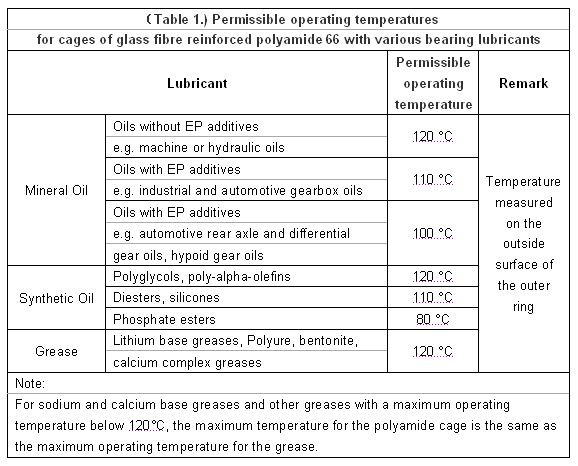?Bearing Technical Data
Dimensions
The boundary dimensions and dimension series of FORTE standard bearings conform to China national GB (State Standard), the technical condition and technical parameters of GB are equivalent to General Plans for the boundary dimensions, which are in conformity with the rules of The International Organization for Standardization (ISO).
· The dimensional plans of metric radial tapered roller bearings in standard GB/T273.1 (equivalent to ISO 355:1977)
· The dimensional plans of metric thrust rolling bearings in standard GB/T273.2 (equivalent to ISO 104:2002)
· The dimensional plans of metric radial rolling bearings in standard GB/T273.3 (equivalent to ISO 15:1998), with the exception of tapered roller bearings
· Limits for chamfer dimensions in standard GB/T274 (equivalent to ISO 582:1995)
· Other interrelated standard: The dimensions of inch tapered roller bearings conform to ANSI/ABMA Standard 19.2-1994.
General Plans
For every standard bearing, by combining a Width or Height Series with a Diameter Series, a Dimension Series, designated by two figures, is arrived at. The first figure identifies the Width or Height Series and the second the Diameter Series (see the table below Dimension Series for radial bearings with the exception of tapered roller bearings).

General Plans for boundary dimensions of radial bearings contain a progressive series of standardized outside diameters for every standard bore diameter arranged in Diameter Series 7, 8, 9, 0, 1, 2, 3 and 4 (increasing outside diameters in this order). Within each Diameter Series different Width Series have also been established (Width Series 8, 0, 1, 2, 3, 4, 5, 6 and 7 increasing width in this order). The Width Series for radial bearings corresponds to the Height Series for thrust bearings (Height Series 7, 9, 1 and 2 increasing height in this order).
Size Range
Depending on the bearing types, FORTE manufactures and supplies different types of bearings size from I.D. 75mm to O.D. 16000mm. Please see the details in Bearing Types and Bearing Application.
Bearing Internal Clearance
Depending on the bearing types, FORTE manufactures and supplies different types of bearings in C2, C0-Normal, C3, C4, C5 and C9-Special clearance.
Tolerance Classes and Symbols
Tolerance Classes:Depending on the bearing types, FORTE manufactures and supplies different types of bearings in P0-Normal, P6, P5, P4, P2 and SP tolerance classes.
Tolerance Symbols:

Materials
The materials from which the bearing components are made determine to a large extent of the performance, service life and reliability of rolling bearings. For the bearing rings and rolling elements, typical considerations include hardness for load carrying capacity, fatigue resistance under rolling contact conditions, under clean or contaminated lubrication conditions, and the dimensional stability of the bearing components. For the cage, considerations include friction, strain, inertia forces, and in some cases, the chemical action of certain lubricants, solvents, coolants and refrigerants. The relative importance of these considerations can be affected by other operational parameters such as corrosion, elevated temperatures, shock loads or combinations of these and other conditions.
To provide the superior quality and high reliability of rolling bearings, FORTE insists on the following quality materials.
Materials for bearing rings and rolling elements
Through-hardening bearing steels
The most common steel for through-hardening is a carbon chromium steel containing approximately 1% carbon and 1,5% chromium. Today, carbon-chromium steel is one of the oldest and most intensively investigated steels, such as GCr15, GCr15SiMn and GCr18Mo steels used in China bearing industry, moreover GCr18Mo steel is a kind of material for the better performance in shock-resistance. Normally, carbon-chromium steel is given a martensitic or bainitic heat treatment during which it is hardened to the range of 58 to 65 HRC.
Case-hardening bearing steels
In applications where there are high tensile interference fits and heavy shock loads, bearings with case-hardened rings and/or rolling elements are recommended, for example, freight train bearings and steel mill rolling neck bearings, which are strongly recommended to use the case-hardening steels. Normally, 20CrNi2MoA, 20Cr2Ni4A, 10CrNi3MoA and 15CrNi4MoA are the materials provided in this field.
Induction-hardening bearing steels
Surface induction-hardening offers the possibility to selectively harden a component's raceway, while leaving the remainder of the component unaffected by the hardening process, so that, a combination of properties can be achieved in one component. Normally, 42CrMo, 50Mn, 5CrMnMo are the materials provided in this field.
High-temperature bearing steels
Standard bearings made from through-hardening bearing steels and case-hardening bearing steels have a recommended maximum operating temperature up to 120 °C. For operating temperatures more than 120 °C, a special heat treatment (stabilization) shall be applied, then the highest operating temperature up to 350 °C is possible to be achieved. In this case a reduction of the load carrying capacity and anti-friction of the bearing have to be taken into account.
For bearings operated at elevated temperatures, higher than 250 °C, for extended periods, highly alloyed steels like Cr4Mo4V, W18Cr4V should be used.
In addition, depending on the bearing type and quantity, bearings made of stainless steels, corrosion resistant steels, high quality and high purity vacuum degassing steels and electroslag remelting steels, etc. are available to be provided.
Cage materials
Main functions of the cage:
· Separation of rolling elements to keep friction and heat development at a minimum.
· Keeping rolling elements at equal distances for uniform load distribution.
· Retaining rolling elements in separable bearings and in bearings which are swiveled out.
· Guiding rolling elements in the unloaded zone of the bearing.
· In grease-lubricated, grease retained inside cage performing a good lubricated condition to the bearing.
Sheet steel cages
The majority of pressed sheet steel cages are made from cold-rolled (hot-rolled) low carbon sheet steel, such as Steel 10# material, etc. These lightweight cages have relatively high strength and can be surface treated to further reduce friction and wear, as well as the internal stress from pressing process.
Pressed cages normally used in the small and medium size bearings. Sheet steel and sheet brass are both applicable for the pressed cages.
Machined cages
Machined cages are majorly made of solid steel, solid brass and textile laminated phenolic resin.s
Machined steel cages
The mechanical strength of machined steel cages is rather more than that of the sheet steel cages. To improve sliding and wear resistance properties some machined steel cages are surface treated.
Machined steel cages are used for large-size bearings or in applications where there is a danger that season cracking, caused by a chemical reaction, may occur if a brass cage were used.
Steel cages can be used at operating temperatures up to 300 oC, which are not affected by the mineral or synthetic oil-based lubricants normally used for rolling bearings, or by the organic solvents used to clean bearings.
There are Steel 20# and Steel 30# materials normally used for machined steel cages.
Machined brass cages
Machined brass cages are normally used for the small and medium size bearings. They are unaffected by most common bearing lubricants, including synthetic oils and greases, and can be cleaned using normal organic solvents.
Brass cages should not be used at temperatures in excess of 250 oC.
There are brass HPb59-1 and bronze QAL10-3-1.5 materials normally used for machined brass cages.
Textile laminated reinforced phenolic resin cages
The lightweight type of textile laminated reinforced phenolic resin cages can withstand high centrifugal as well as acceleration forces, but are not able to accommodate high operating temperatures. In most cases, these cages are used as standard in high-precision angular contact ball bearings.
Polymer cages
· Polyamide 66
For the majority of injection moulded cages polyamide 66 is used. This material, with glass fibre reinforcement, is characterized by a favourable combination of strength and elasticity and sliding performance. Such cages enable bearing still kept on operating under the brief period greaseless running condition due to its smooth sliding performance. The mechanical properties like strength and elasticity of polymeric materials are temperature dependent and subject to permanent changes under operating conditions, called ageing. The most important factors that play a role in this ageing behaviour are temperature, time and the medium (lubricant) to which the polymer is exposed. The relationship between these factors for glass fibre reinforced polyamide 66 is illustrated in the following Table 1. It appears that the cage life decreases with increasing temperature and the aggressiveness of the lubricant.
Towards the low operating temperature side, also a limit can be set since polyamide loses its elasticity which can result in cage failures. Cages made from glass fibre reinforced polyamide 66 should for this reason not be applied at a continuous operating temperature below –40 °C.
·Polyamide 46
Glass fibre reinforced polyamide 46 is used for some small and medium size toroidal roller bearings as standard. These cages have a 15 °C higher permissible operating temperature than those made from glass fibre reinforced polyamide 66.

Seal materials
Seals in FORTE bearings are normally produced from acrylonitrile and butadiene, this copolymer called acrylonitrile-butadiene rubber (NBR), is the "universal" seal material, which shows good resistance to the following medias
· Most mineral oils and greases with a mineral oil base.
· General fuels, e.g. petrol, diesel and light heating oils.
· Animal oil, vegetable oils and fats.
· Hot water.
It also tolerates short-term dry running of the sealing lip. The permissible operating temperature range is –40 to +100 °C, for brief period temperatures of up to +120 °C can be tolerated. At higher temperatures the material may harden to failure.

